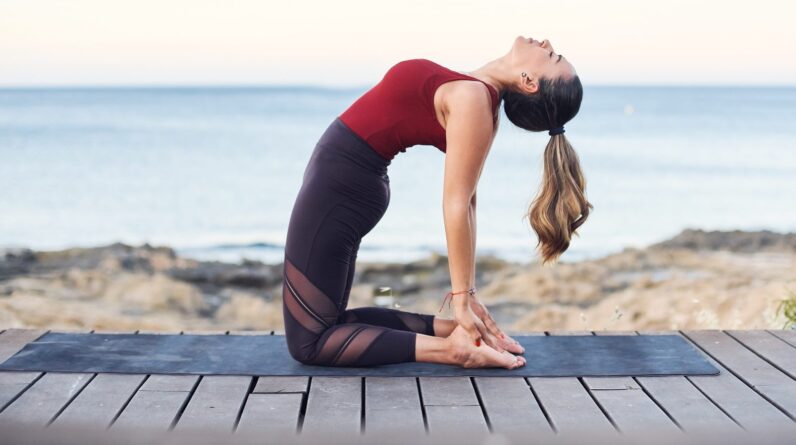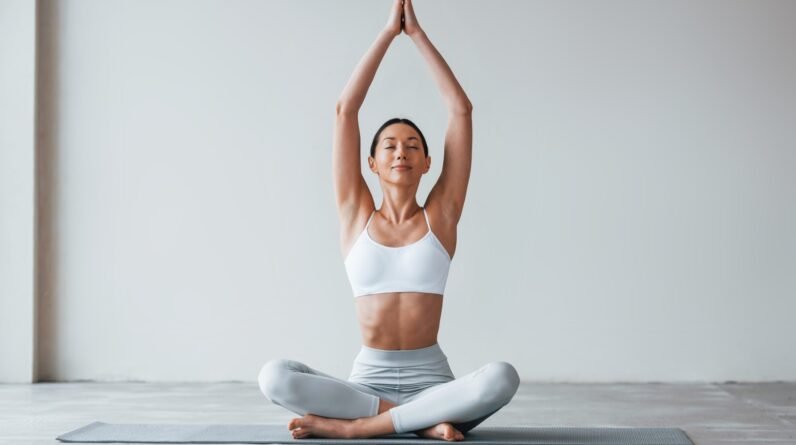
Ustrasana helps enhance your spinal mobility and improves your posture. Here are the benefits of camel pose and how to do it.
Ustrasana is also known as the camel pose. The name “Ustrasana” is derived from Sanskrit, and combines the words “Ustra,” which means camel, and “asana,” which means seat or posture. This pose helps to open up your chest and back. It is beneficial for easing lower back stiffness and reducing slouching. It is perfect for people who spend a lot of time sitting in front of a desk. As a result, the camel pose might be beneficial to anyone looking to improve their flexibility and strength. This pose offers a plethora of health benefits, here’s everything you need to know about ustrasana.
What are the benefits of ustrasana or camel pose?
Here are some of the potential benefits of ustrasana or camel pose, as explained by yoga expert Dr Hansaji Jayadeva Yogendra.
1. Promotes digestion
If you are suffering from poor digestion problems, including camel pose in your yoga routine might be helpful. According to a study published in the International Journal for Research, the regular practice of ustrasana improves digestion and also helps to alleviate constipation.

2. Improves posture
Most people spend the day sitting or slouching. Ustrasana stretches the chest, abdomen, and quadriceps, which may help improve your posture. Camel pose may improve spinal mobility by stretching the back in the opposite direction, according to a study published in the International Journal of Research.
Trust 3 yoga asanas to help you fix your posture
Also Read

3. Increases oxygen flow
“Camel pose or ustrasana increases oxygen consumption, which may lead to lung expansion. As a result, the body’s oxygen flow increases. Increased oxygen flow improves respiratory rate and reduces the work required by our body to breathe,” says the expert.
4. Gives relief from hernia
Hernia happens when one of your organs pushes through the muscle tissue. It usually occurs in the groin or abdomen. Ustrasana may help reduce stress, decrease anxiety, and improve digestion. As a result, doing ustrasana can help strengthen the gut and provide relief from intestinal and stomach hernias, according to a study published in the Pragya Yoga Journal.
5. Reduces lower back pain
“The camel pose may be effective for stretching and extending the front, back, and neck muscles of the body. Ustrasana may help strengthen the neck while lowering cervical strain. Additionally, it might help to strengthen the muscles in the back, knees, shoulders, and arms. This could lessen the pain in your lower back,” explains the expert.
6. Gives relief from menstrual cramps
Menstrual cramps are always the dreadful highlight during the menstrual cycle. But, now you can ease this pain by incorporating camel pose into your yoga routine. Women benefit notably from camel poses. Menstrual pain can be reduced by doing this pose. It also helps to open the pelvic region which , found a study published in the World Journal of Pharmaceutical Research.
7. Tones thigh, hip and back muscles
If you don’t like weightlifting or cardio workouts to tone your thighs and glutes, doing ustrasana can be helpful. Regularly doing the camel pose and holding the pose for about a minute will help to tone up the thighs, hips, glutes, and back muscles of the body, according to a study published in the International Journal of Research.
8. Boosts immunity
Are you tired of getting sick the moment it gets a little cold? A study published in the previous journal also states that practicing ustrasana can help boost your immune system and keep your infections at bay.
These 5 yoga techniques will give your immunity an extra push
How to do ustrasana or camel pose?
Here is a complete guide to doing ustrasana or camel poses, as explained by the expert.
- Step 1: Get on a mat and stand on your knees. Keep your back straight with your knees and feet together.
- Step 2: Lean back slowly and move a little more backward. Reach for the right heel with the right hand and the left heel with the left hand. Do not put unnecessary strain on your body.
- Step 3: Push your hips in the forward direction. Thighs should be kept vertical.
- Step 4: Then bend the head and spine as far back as possible without straining.
- Step 5: Let your body and your back muscles relax.
- Step 6: Support the body’s weight equally on the legs and arms.
- Step 7: Keep the arms in such a way that they anchor the shoulders to maintain the back arch. Hold onto this posture as long as it is comfortable for you.
- Step 8: Then, release your hands, one at a time, from the heels and return to the beginning position.

Are there any side effects of camel pose?
While camel pose is generally considered safe, it is critical to avoid overexertion. Mindful execution with proper alignment is essential for your safety. However it is crucial to pay attention to the signals of your body. You can modify poses as needed, and get advice from an experienced instructor, especially if you have any particular health issues, advises the expert.







